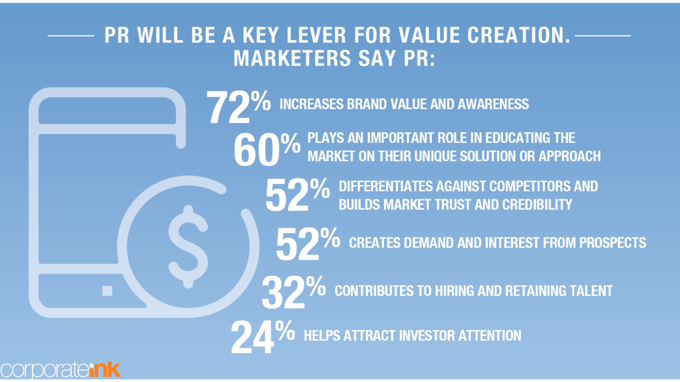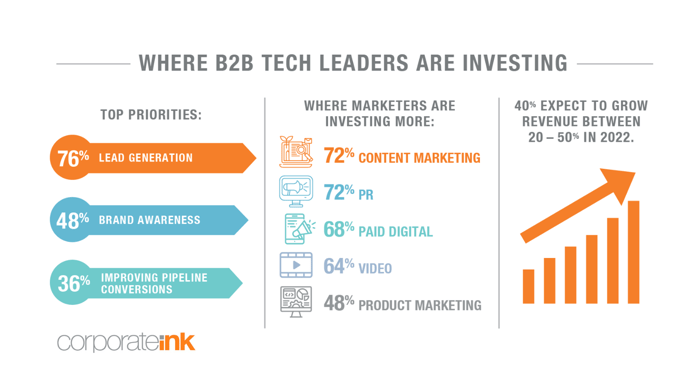March 25, 2022
 by Greg Hakim / March 25, 2022
by Greg Hakim / March 25, 2022

It’s time to rethink PR measurement.
B2B technology and SaaS communicators have been at it for a while and honestly haven't made much progress. While there is a wealth of data to track, it rarely stands on its own and sometimes doesn't even matter.
Consider the main promise of PR: awareness. Raising awareness is great but very vague. Smart marketers recognize that awareness for the sake of awareness is never enough and never will be, especially in competitive and high-growth markets.
Instead, think bigger. Be bold with your PR strategy. Expand your measurement parameters. Your PR program can help drive more meaningful goals. To get the roadmap right, think about sales, competitive preferences, talent, acquisitions, financing, and more.
PR measurement is the process of measuring the impact of one or more public relations (PR) activities. PR metrics measure PR performance and help gauge how a given marketing campaign performs.
Measuring the value of PR and connecting your strategy to your business objectives is critical but not easy.
Why should you measure PR impact? Simply put, you need to ensure your investment, both internal and external, is justified. When your PR program is a business and revenue driver rather than a cost center, you can continually expand, experiment, and invest for greater impact.

Source: Corporate Ink
At a deeper level, markets are incredibly competitive and noisy. Just doing PR isn’t enough. Generating coverage, winning a few awards, and issuing press releases are also not enough. PR needs to drive something bigger and be measured relative to your competitive landscape and market opportunity.
For example, the most mature programs measure their results against their competitors. Winning business and building market preference requires you to go beyond awareness to differentiate and build exposure at a higher rate than your competitors. If PR contributes to 10% annual growth, but the market is growing at 40%, something is clearly wrong. And your PR program may be part of the problem (but probably not the only problem).
Measurement is also key to advancing your career. The science behind PR can be hard to grasp for those who don't live it every day. Hard data makes it easier to see the value behind what you do and why you deserve more opportunities.
Of course, PR can't always stand alone. And that's okay too. Many PR executives struggle with attribution, which is understandable. How you talk about PR and think about measurement makes all the difference.
For example, showing how PR is helping your business grow as part of a larger and integrated strategy is more valuable than measuring the specific impact of a single PR effort. Build your measurement framework and set expectations accordingly.
Before we go further, let’s take a minute to state what’s (hopefully) obvious: traditional and old-school PR metrics like circulation, ad value, and the number of clippings and press releases are dead. If your agency still uses similar metrics, it’s time to re-evaluate your PR partners and strategy. If your boss still asks for these metrics, you need to educate them on what’s possible.
Digital PR key performance indicators (KPIs) offer more value. Start with a competitive share of voice (SOV) that measures your brand awareness relative to your competitors. This helps determine how you fare in your specific market.
But remember, company size and scale can greatly influence SOV. The key is benchmarking at the beginning of your journey and tracking how much share you gain and take away from your competitors.
Be realistic about what’s possible, and remember that gains require you to outpace others, not just increase your own output. Measure PR quarterly, as the week-to-week and month-to-month fluctuations in the news cycle create too much volatility.
Then look at the KPIs and messaging behind your coverage and PR achievements. Does your PR program drive marketing and sales? Does it result in on-message coverage that reaches the right audience? How much engagement does your social media, email, and website generate? Can you track the impact of coverage on the pipeline and revenue?
You can answer all these questions with the right strategy, alignment, and technology.
PR measurement as a concept is simple. However, measuring how much value your PR efforts generate is far more difficult.
The first step in measuring PR’s impact is going beyond the basics. Start by evaluating your goals: what’s the most important goal you want to achieve?
If your answer is purely PR-driven, you could opt for awareness, media reach, the share of voice, news penetration, PR distribution, business press acquisition, and so on. But you need to think bigger. While PR metrics like these are valuable and important to measure, they’re limiting.
The more strategic way to measure PR is to tie your program to your company's strategic goals like sales, competitive differentiation, acceptance, new markets, and investments.
of marketing leaders said PR adds value by educating the market about a tech provider's unique approach or solution.
Source: CorporateInk
Another 52% said PR helps generate demand and interest from prospects and sets them apart from competitors, while 24% said PR helps attract investor attention.

Source: Corporate Ink
What do all these results have in common? They drive something substantially more meaningful than awareness. Understanding that PR is a means to an end and not the end itself is paramount to effectively measuring value and impact and developing a growth strategy.
Before diving deep into PR metrics, remember to go beyond PR first. Identify your goals and work backward.
For example, if you focus on talent acquisition, you should set a corresponding KPI such as the number of qualified applicants.
Your PR program shouldn’t be solely responsible for these outcomes, but it should help drive success and play into the overall marketing and sales strategy. Once you’re aligned with your goals and have a plan to track business impact, dive into the PR data.
Here are eight KPIs worth baselining and measuring:
While PR measurement is undoubtedly complex, there’s no shortage of KPIs to track. Your PR program probably won't control all of these KPIs, and some may not be right for your business. Or maybe they're all important, but you don't have the resources to track them all. That's okay.
Think about your intended outcome first, and then prioritize the PR metrics most valuable in achieving that outcome. Prioritization always brings clarity.
There are many technologies that can help measure PR. Start by integrating with marketing and sales. Integrate with your marketing automation platform, CRM, Google Analytics, social media management tools, account-based marketing ABM technologies, and other relevant solutions. You can check out G2's list of Best Marketing and Digital Advertising products.
Then, look at PR-specific measurement tools, like Cision, Critical Mention, Meltwater, Muck Rack, Onclusive, and Memo, among others.
Start with a strategic alignment map to create a PR measurement framework. Identify your objectives and key results (OKRs) and what your business needs to do to achieve them.
This map should contain your strategic business goals and identify the critical milestones and achievements required for achieving the set goals.
Then work on your PR comes: how will your PR strategy shape and drive success?
Finally, look at the hard PR KPIs: how does your PR program impact you, are you meeting your goals, and how much do you improve over time?
The PR tactics you invest in should drive and influence the KPIs and mid-level goals, which also drive your outcomes. Map everything together with intentionality and purpose, and partner with key stakeholders across the business to ensure alignment.
For global PR programs, create multiple frameworks. Leverage a core corporate PR strategy to guide local activities and develop supporting strategies and specific measurement frameworks for your key regions. Report both globally and locally and share what’s working across markets. Your wins in one market can often be repurposed and localized for another.
Don’t shy away from PR because it’s hard to measure. The stakes are too high for that.
The pandemic ushered in a digital disruption that accelerated SaaS competition and expanded addressable markets. This also created opportunities and made it much harder to stand out.
Take supply chain technology as an example. Few paid attention to supply chain management two years ago. Contrary to this, supply chain startups raised over $24.3 billion in venture funding in the first three quarters of 2021, 58% more than in 2020.
Talk about an increase in competition and noise. In such cases, doing nothing is even worse than it seems because your competitors won’t sit still. The mindshare gap increases every day they act, and you sit idle.
Another critical point: our society struggles to trust. Blame it on politics, the pandemic, broken promises, or something else entirely. Either way, this dynamic translates into the workplace and affects everything from sales to hiring.
While PR won’t solve our society’s trust issues, good PR is essential as it solves PR crises and builds credibility, increases favor, and reduces skepticism across the sales cycle.
Marketers have long struggled to quantify the impact of PR. Part of the problem is the BS vanity metrics that agencies and communicators pushed for so long. Another potentially significant issue: too many folks are afraid to admit that PR is a means, not an end.
When you think about PR more holistically and recognize that it’s part of something bigger and not a standalone investment, it becomes easier to measure impact and value. Think of PR as a journey and an enabler, not a single action or event.
That said, don’t stand for vague promises or service agreements. PR must drive business outcomes.
Your team and partners should show three things at a minimum:
The third question is the most important. When you connect your program to your end objectives, you can measure how it’s helping you with what matters most – growth, new product launches, hiring, strategic exits, and more. We can all agree this is much better than the vanity metrics.
Public relations can be tricky and getting it right isn't the easiest of tasks. Learn everything you need to know about PR.
Greg Hakim is CEO of Corporate Ink, a B2B tech PR and content marketing agency specializing in supply chain and procurement, enterprise risk, AI and automation, workforce management tech and sustainability.
Influencer marketing has vastly grown over the last number of years, and has no intention of...
 by Steve Habazin
by Steve Habazin
Although many people understand that employee engagement is important for a thriving company...
 by Courtney Moran
by Courtney Moran
Each engineering team is unique in how they are structured, operate, and execute their...
 by Karanvir Gupta
by Karanvir Gupta
Influencer marketing has vastly grown over the last number of years, and has no intention of...
 by Steve Habazin
by Steve Habazin
Although many people understand that employee engagement is important for a thriving company...
 by Courtney Moran
by Courtney Moran


